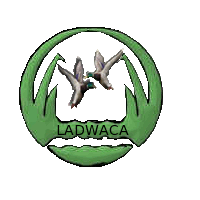MUDPATTENS >>
To overcome those stickier moments out wildfowling, Nick Horten has devised a mud patten that should enable you to keep out of the quagmire

ESTUARINE MUD..
..often black, glutinous and stinking, is the very stuff of which wildfowling is made. Home to the myriad small creatures and plants upon which the duck, geese and waders feed, it frequently seems possessed of a life of its own as it creeps insidiously about the fowler's boots, clothing and gun.
Fortunate, in respect of his personal hygiene, is the fowler whose estuary consists of sand. More inert by nature than mud, although perhaps more damaging should it find its way into the action of his gun, sand, when it is not of the quick variety, is at least easy to walk upon.
Not so the mud, which, as it progresses from boot sole to calf, knee and thigh in depth, becomes more leg and heart muscle straining. If the mud does go much beyond your thigh, you won't be going anywhere. Such is the perversity of wildfowling that the best shooting areas frequently require the crossing of large expanses of open mud. If a boat at full tide is not a practical proposition, then the gunner really has little option but to walk.
more mud..
Anyone who has lugged gun, cartridges, a sackful of decoys and the makings of a hide more than a few hundred yards across mud little more than even ankle depth will appreciate the true meaning of having to work for their birds. The obvious solution to this problem, then, is to use mud pattens. Stout wooden boards tied to the fowler's feet, their purpose is to spread his weight over a greater surface area, thereby preventing him from sinking. Simple enough in theory, but what of the practicalities? Most of the great wildfowling authors have touched upon their design and use. Colonel Hawker's mud boards work well enough but the large oval boards fastened to the foot with leather straps as recommended by Sir Ralph Payne-Gallwey are positively dangerous. Indeed, the more you research the subject, the more it becomes apparent that, while widely understood in principle, few have grasped the simple essentials of safe mud walking.
The harbours of Portsmouth. Langstone and Chichester contain a particularly viscous brand of sediment. Many years ago those with business about the harbours - cocklers, bait-diggers, flight shooters and puntgunners - perfected the design of their mud pattens. The boards themselves are nothing revolutionary: 12in square with rounded corners. Traditionally, they are made of elm, although marine or even exterior-grade, plywood will give years of service. Hardwood strips fastened to the bottom, traditionally with copper rivets, although brass screws and waterproof wood glue will suffice, provide the necessary grip to prevent sliding.
The Secret..
The secret lies not so much in the board's dimensions, but in the positioning of the foot and the precise method of fastening. Two rope loops secured under the board with a figure-of-eight or stopper-knot provide the anchor points for the rope ties. Place the foot between, and parallel to, the fixed loops, with the toe level with the leading edge. Once fastened, it is possible to walk normally. There is no need to adopt the tiring and unnatural gait necessary as when the foot is placed in the middle of the board.
Boards that overlap the toe require an awkward flatfooted gait. With each step it is necessary to overcome the suction of the mud. A normal walking gait has the effect of pushing the overlap further into the mud. All this places an additional strain upon both the loops and the fastening ties. With the foot correctly positioned, it is possible to walk normally. In this way there is less suction to overcome, therefore less strain on the fastenings.
It is possible to kneel comfortably, an important consideration for the shoulder gunner; it is even possible to climb steep creek banks without fear of wrenching the patten from your foot.
Cheap polypropylene rope is quite adequate for both board loops and ties.
Avoid expensive nylon or terylene rope - it has different design characteristics and is inclined to slip when knotted. It is worth hunting out some old-fashioned hemp rope, particularly for the ties. It binds well to itself and gives a secure knot. Should you decide to use natural cordage it must be inspected regularly and replaced immediately any wear becomes apparent. Like the puntgunner's breaching rope, your life may depend upon it not parting at an inopportune moment!
When securing the loops to your boards, it is imperative that you use a figure-of-eight knot. Instruction on how to tie it is available in any good book about basic seamanship. Don't be tempted to use a simple overhand knot. It will slip with disastrous consequences.
Having secured the pattens firmly to your feet, the following provide a few tips on their use:
Firstly, remember that you have them on! A slight adjustment of your gait may be required to avoid stepping one on the other. A few minutes practice on the lawn may prevent a potentially disastrous tumble on the mud.
When walking, you may experience a slight build-up of mud on the leading edge of the patten. A quick flick of the foot will remove it.
Always carry a couple of spare ties. to be used in the event of a sudden breakage, and your having to cut a rope.
Lastly, remember that patterns should be looked upon as an aid to easing your passage across the mud. They are not magic! Do not use them to attempt to cross mud so slack that the patten itself sinks into it.
Used with care and commonsense, this simple, old-fashioned device could considerably broaden your fowling horizon.






